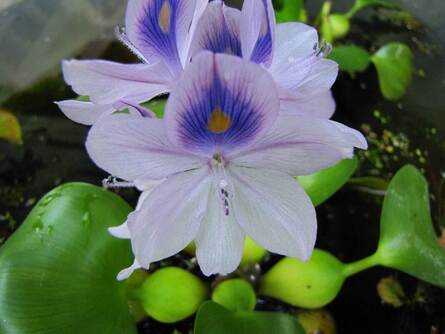|
This is a guest blog post from Melinda Myers Photo credit: Paul Skawinski Water Hyacinth (Eichhornia crassipes) is an aquatic invasive species that can grow quickly, forming dense mats that restrict light to the underwater environment. In February, I asked for your help spreading the word about the impact aquatic invasive plants have on Wisconsin lakes and waterways. Now that summer has arrived and we are spending more time outdoors, you may encounter gardens and natural spaces where these plants are growing. So once again, I am asking for your help.
Start by familiarizing yourself with the more common aquatic invasive plants. For some, this may be a review while others may be surprised to find some beautiful plants are actually problem plants that need to be removed. See Regulated Aquatic Invasive Plants in WI and Common Wetland Invasive Plants in WI for pictures of restricted and prohibited species. The Wisconsin Invasive Species Calendar from the University of Wisconsin Madison First Detector Network is also a helpful tool. It provides a timely reminder of invasive plants to watch for throughout the season based on their life stage and visibility. A new video “Identifying Eight Aquatic Invasive Species in Wisconsin” provides images and identification clues you may find helpful as you enjoy the outdoors and tour gardens. For more detailed information and images of native and invasive aquatic plants see Paul M. Skawinski’s book Aquatic Plants of the Upper Midwest – Fourth Edition. It is available from the Extension Lakes Online Bookstore where you can also find the updated Wisconsin AIS Early Detector Handbook. To learn more about the distribution and control methods for invasive plants you are concerned about contact your regional WI DNR AIS Coordinator found here[JSS1] [JSS2] . If you discover aquatic invasive plant populations in public spaces and waterways, please report them to the Wisconsin Department of Natural Resources (WI DNR) so they can contain and manage the problem. You will find the details for documenting and reporting aquatic invasive species on the WI DNR's Invasive Species Reporting page. Also, watch for invasive plants as you visit and consult with gardeners throughout the summer. When invasive plants are found be sure to make it into a learning opportunity. First assure the gardener that many of us have purchased plants in the past unaware they would eventually become a problem for native plants, wildlife, and beneficial insects. As more gardeners are now purchasing plants online it increases the risk that prohibited and restricted plants find their way into Wisconsin. Add to this the fact that there are many new gardeners that may not be aware this problem exists. Help them understand that how we plant and manage our gardens has an impact on Wisconsin’s natural spaces. Growing even one or two invasive plants in your garden, shoreline planting or pond can have an impact. Invasive plants tend to be vigorous growers, reproducing faster than our native plants, and are more tolerant of adverse conditions. This allows them to quickly spread, take over and cause harm. Advise gardeners on how to dispose of invasive plants properly. Composting is usually not the best option. Most of us do not create compost piles that reach high enough temperatures to kill these weeds, insects, and diseases. To prevent them from invading natural areas it is best to bag and dispose of invasive plants in the trash. The more people you reach with this important message the more gardeners there will be helping in the containment and management of these plants. My AIS partners at UW Madison Extension and the WI DNR AIS remind us that “maintaining and restoring our waters and landscapes can reduce the impacts even when we don’t have other management options for an invasive species. Reporting invasive species is a first step in containing their spread.”
0 Comments
Leave a Reply. |
|
| North Country MGV | gARDEN bLOGS |
Location |
|

 RSS Feed
RSS Feed